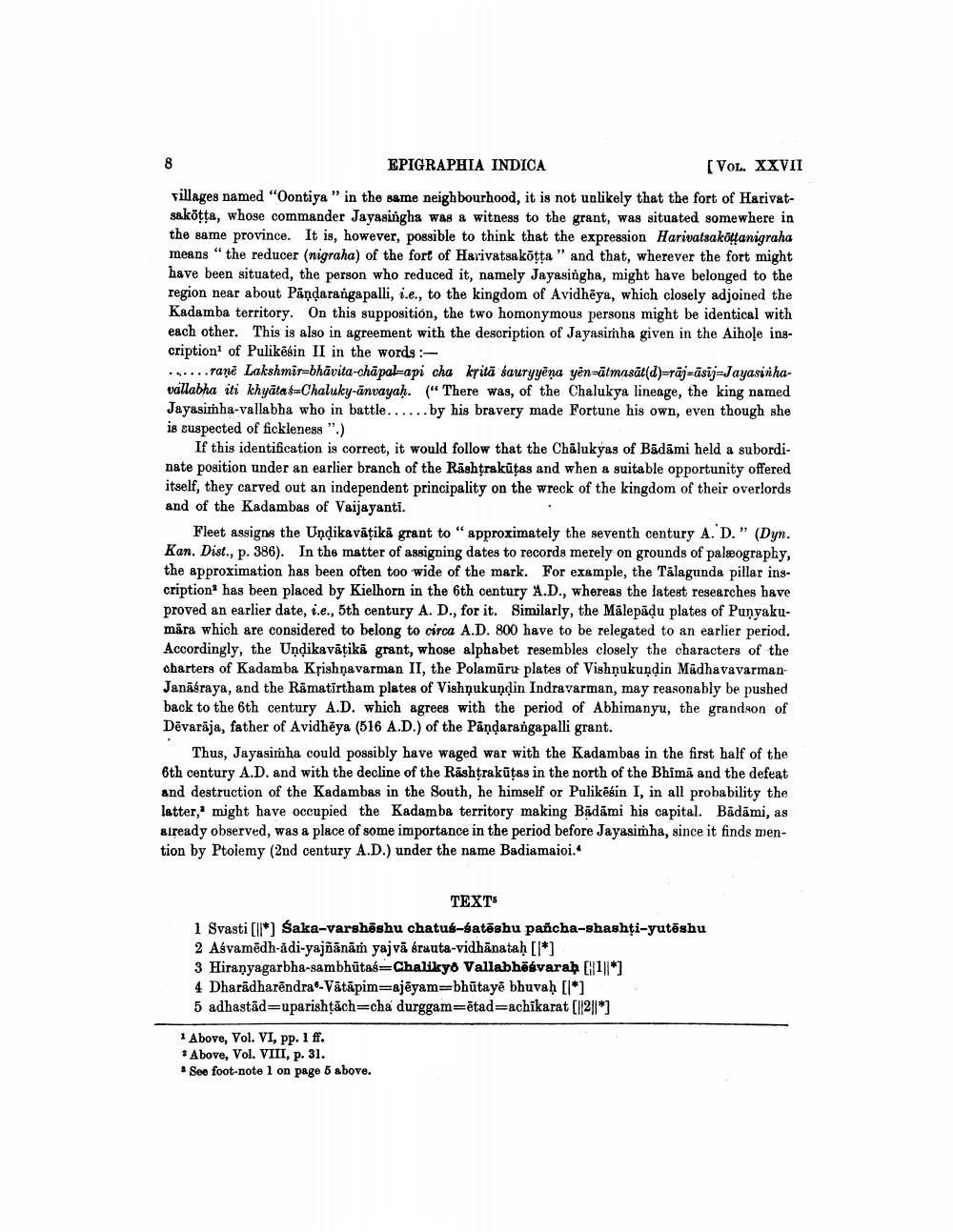________________
EPIGRAPHIA INDICA
(VOL. XXVII
villages named "Oontiya" in the same neighbourhood, it is not unlikely that the fort of Harivatsakõtta, whose commander Jayasingha was a witness to the grant, was situated somewhere in the same province. It is, however, possible to think that the expression Harivatsakodanigraha means "the reducer (nigraha) of the fort of Harivatsakötta" and that, wherever the fort might have been situated, the person who reduced it, namely Jayasingha, might have belonged to the region near about Pandarangapalli, i.e., to the kingdom of Avidhēya, which closely adjoined the Kadamba territory. On this supposition, the two homonymous persons might be identical with each other. This is also in agreement with the description of Jayasimha given in the Aihole inscription of Pulikēsin II in the words :......ranë Lakshmir-bhāvita-chāpal-api cha kritā sauryyena yen-ātmasāt(d)=rāj-asij-Jayasinhavallabha iti khyātas-Chaluky-ānvayah. (" There was, of the Chalukya lineage, the king named Jayasimha-vallabha who in battle...... by his bravery made Fortune his own, even though she is suspected of fickleness".)
If this identification is correct, it would follow that the Chalukyas of Bādāmi held a subordinate position under an earlier branch of the Rashtrakūtas and when a suitable opportunity offered itself, they carved out an independent principality on the wreck of the kingdom of their overlords and of the Kadambas of Vaijayanti.
Fleet assigns the Uņdikaväţikä grant to "approximately the seventh century A. D." (Dyn. Kan. Dist., p. 386). In the matter of assigning dates to records merely on grounds of palæography, the approximation has been often too wide of the mark. For example, the Tālagunda pillar inscription has been placed by Kielhorn in the 6th century A.D., whereas the latest researches have proved an earlier date, i.e., 5th century A. D., for it. Similarly, the Mälepădu plates of Punyakumära which are considered to belong to circa A.D. 800 have to be relegated to an earlier period. Accordingly, the Uņņikavātikā grant, whose alphabet resembles closely the characters of the charters of Kadamba Křishṇavarman II, the Polamūru plates of Vishņukuņdin MädhavavarmanJanābraya, and the Rāmatirtham plates of Vishnukundin Indravarman, may reasonably be pushed back to the 6th century A.D. which agrees with the period of Abhimanyu, the grandson of Dēvarāja, father of Avidhēya (516 A.D.) of the Pāņdarangapalli grant.
Thus, Jayasimha could possibly have waged war with the Kadambas in the first half of the 6th century A.D. and with the decline of the Rāshtrakūtas in the north of the Bhim, and the defeat and destruction of the Kadambas in the South, he himself or Pulikēsin I, in all probability the latter, might have occupied the Kadamba territory making Badāmi his capital. Bādāmi, as already observed, was a place of some importance in the period before Jayasimha, since it finds mention by Ptolemy (2nd century A.D.) under the name Badia maioi.
TEXTS 1 Svasti (Il*] Saka-varshēshu chatus-satēshu pancha-shashți-yutēshu 2 Asvamēdh-adi-yajñānāṁ yajvā brauta-vidhānataḥ [I*] 3 Hiranyagarbha-sambhūtas=Chalikyo Vallabhāśvara (111*] 4 Dharadharēndra-Vätāpim=ajęyam-bhūtayē bhuvaḥ [l*] 5 adhastād=uparishţāch=cha durggam=ētad=achikarat [1/2]*]
1 Above, Vol. VI, pp. 1 ff. * Above, Vol. VIII, p. 31. See foot-note 1 on page 5 above.




